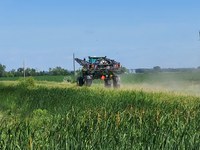Prevent accidents when farm equipment shares the road
(Click the image below to view a high-resolution image that can be downloaded)
With variable weed, insect and disease pressures this growing season, many farmers are keeping their sprayers handy. As farmers accumulate miles of road time on their sprayers and other farm equipment, Angie Johnson, North Dakota State University Extension farm and ranch safety coordinator, reminds equipment operators and motorists to keep road safety in mind.
“Remember, farm machine operators and motorists must share the road,” says Johnson. “Whether you’re driving a sprayer or a car, use your defensive driving skills.”
From 2016 to 2019, the North Dakota Department of Transportation Safety Division recorded 212 motor vehicle crashes involving farm equipment. Of those, 70% occurred at non-junctions on roadways, while 22% occurred at intersections.
Johnson recommends the following safety tips for farm machine operators:
- Be visible. Use hazard lights and turn signals and a slow-moving vehicle sign to communicate with motorists.
- Take time to wash your machine’s windows to remove any dirt that may obstruct your vision.
- Consider installing a camera system that allows you to see motorists from behind while traveling. In many self-propelled sprayer cabs, visibility for the operator is reduced because of large tanks behind the cab and folded booms on the side of the cab, reducing operator visibility.
- Make sure all light systems work and are visible before traveling on a public roadway.
- When preparing to turn off a roadway, turn your hazard lights off briefly before making your turn. This strategy helps breaks up the visual that a motorist has been seeing over a long period of time and can help “snap” them back into attention. Then, use your turn signals to warn motorists that you will be making a right or left turn, even if it is not at a typical roadway intersection, such as a at field approach or entrance.
- Be aware of your surroundings by planning your route to the field before getting behind the wheel. Identify hazards, such as low hanging powerlines, mailboxes, road signs, narrow bridges, railroad crossings or washed out/closed roads that may cause an incident.
- Obey traffic signs. Just as a motorist would obey a yield sign or stop sign, equipment operators must also obey road signs too.
- While driving on narrow roads, such as a county or township gravel road, yield and safely pull over for oncoming traffic. When possible, pull over on an approach.
- Plan ahead by driving your equipment on public roads during times when traffic conditions are reduced. Understanding your local traffic patterns can help you avoid times with an increased volume of motorists on the roadways.
- Stay in your lane. It is the equipment operator’s responsibility to stay in their lane, and that includes any machinery pieces that are wider than the size of the road lane.
Safety tips for motorists include:
- Be prepared to slow down when you see flashing hazard lights and a slow-moving vehicle sign, as this may indicate that you are approaching a sprayer or other farm machinery from behind. When you see this sign, slow down and stay back at least 50 feet from the machine. If you are driving your car at 55 mph and come upon a tractor that is traveling at 15 mph, it only takes five seconds to close a gap the length of a football field between you and the tractor. Most sprayers and farm machines are not designed to travel at speeds greater than 25 to 30 mph.
- Never assume that it is safe to pass farm equipment. Farm machine operators may drive from field approach to field approach. Look for possible driveways or field approaches that the equipment operator may turn into.
- Passing is risky. Even if the sprayer or equipment operator seems to be pulling over to allow you to pass, consider other dangers of the situation, such as oncoming traffic you may not be able to see and protruding equipment pieces, such as the folded shanks of a digger. Remember to watch for approaches. The equipment operator may be preparing to turn, not pulling over.
- Be alert for when the equipment may make a turn. Because farm equipment is so large, making right and left turns can be challenging. When making left turns, farm machine operators will “swing” their equipment far out to the right side of the road before making a left turn. Slow down and do not assume it is safe to pass. Allow the machine operator to complete the turn, as they may have restricted rear visibility and not know you were approaching directly behind them.
“Regardless of whether you are driving farm equipment or a motor vehicle, wear your seatbelt and put the cellphone away,” says Johnson. “Distracted driving is dangerous and illegal.”
“Take the time to be patient this spraying season while sharing the road with motorists and farm equipment operators,” she adds. “Practice defensive driving skills by slowing down, being alert and prepared before going out onto the roadway.”
For more farm equipment road safety information search online for "NDSU Tractor and Road Safety."
NDSU Agriculture Communication – July 14, 2022
Source: Angie Johnson, 701-231-1873, angela.b.johnson@ndsu.edu
Editor: Elizabeth Cronin, 701-231-5391, elizabeth.cronin@ndsu.edu


